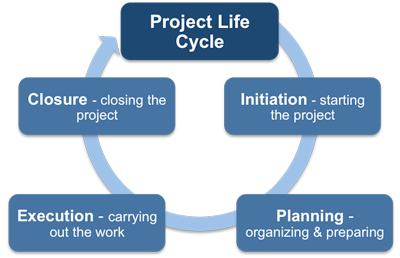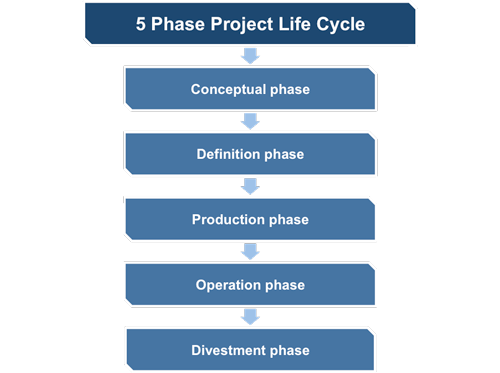Project Life Cycle Definition
There is very little agreement about the life cycle phases of a project and many organizations have their own internal definitions and templates. This is understandable because of the complicated nature and diversity of projects, which can vary enormously in size and complexity.
 |
Despite this, all projects can be mapped to the following simple life cycle structure:
1. Starting the project
2. Organizing and preparing
3. Carrying out the work
4. Closing the project
This is known as a four-phase life cycle and the phases are usually referred to as:
1. Project Initiation
2. Project Planning
3. Project Execution
4. Project Closure
Each of these phases is made up of discrete activities, each of which has an associated definition and guidelines. The number of activities depends on the scope of the project.
A simple project will involve only a few activities while a more complex project may involve hundreds or thousands of individual activities. This model can be applied to a variety of project scenarios although the cost and duration of each phase will vary according to the particular project. Projects are temporary structures set up with the specific aim of delivering an identifiable end-product. All projects will therefore have an identifiable life cycle, the characteristics of which will vary according to the size and complexity of the project.
For example, in the case of a project whose aim is to evaluate, recommend and implement a computerized accounts system. The costs of the project are restricted to the selection of the most suitable system available and the training and implementation necessary for its introduction. The actual purchase of the system is not within the terms of reference of the project, as this capital cost will be taken from a separate budget.
A typical life cycle will run from the formal initiation of a project through to a post implementation review of the delivered end-product. This post implementation review is not shown as it is usually held some months after the project has been formally closed. There is often little agreement between industries, or even between organizations within the same industry, about the life cycle phases of a project. This is understandable because of the complicated nature and diversity of projects.
A five phase project life cycle model can be applied to a variety of project scenarios although the cost and duration of each phase will vary according to the particular project. The conceptual phase includes the preliminary evaluation of an idea. It is common for this phase to include a first cut feasibility study for the proposed project. This analysis should also include a preliminary risk assessment.
 |
The definition phase is primarily a refinement of those areas considered in the conceptual phase. The resources required by the project should be defined along with time, cost and performance estimates. Project estimation is a difficult task - especially in this early phase. However it is essential that costs are quantified, as this information is needed to establish whether or not the project should proceed.
Once a project has received the funding and backing of senior management it can proceed to the production phase. This incorporates the production, or acquisition, of the end-product specified. This begins with the updating of detailed plans, started in the preceding phases and encompasses the identification and management of the resources required. This phase also includes the development of manuals, plans and other documentation that will support the end product in its live environment.
The operation phase involves the integration of the end-product or service into the organizational environment. If the end-product was a marketable product then this phase would typically include the product life cycle phases of marketing and refinement. The divestment phase involves the reallocation of resources that are no longer required by the current project. The end-product of any project will have a finite lifespan and therefore its ability to generate revenue will be limited. The organization will usually need to run future projects to guarantee its revenue stream.
It is therefore important to retain the services of staff and other resources that can be used in forthcoming projects. This phase also incorporates the post implementation evaluation of the delivered end-product, and this should serve as input to the conceptual phase of future projects.
The use of resources over time will vary according to each particular project. Whilst it may be possible to characterize life cycle profiles within different industry sectors, this can give a false impression as individual projects can vary radically from the generic profile.
You may also be interested in:
Project Management Principles | Project Management Definition | Project Management Perspectives | Project Organization and Structure | Projects in a Matrix-Management Environment | Project Stakeholders Definition | Project Sponsor Definition | Project Life Cycle Definition | Functional Areas of Project Management.
|
|


